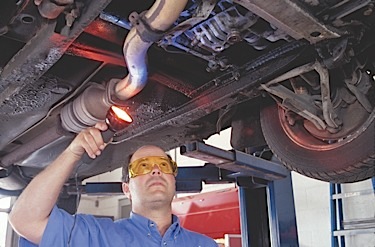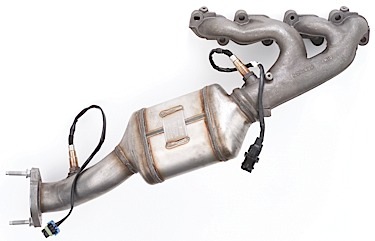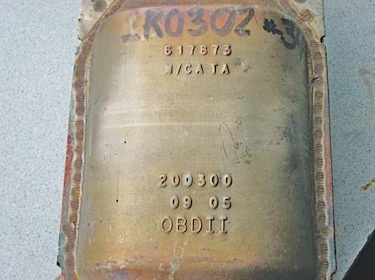

If your shop is not in California, the replacement of the catalytic converter is simple and typically there is only one replacement option. Most shops understand that they must replace the converter and that using a test pipe or bypassing the converter is bad for business and against the EPA regulations and could result in big fines.
Converters must be certified and be labeled with the correct codes that are stamped into the shell. You can not just install a converter that matches the size and shape. Certified converters may have more precious metals and catalyst biscuits.
Another problem is within the calibration of the ECM of the vehicle. California emissions-certified vehicles may have more sensitive oxygen sensor calibrations. If a non-certified converter is used, the efficiency codes may go away at first. But, they could return after the catalyst becomes loaded with contaminates.
This year, things are getting complicated. It is starting in New York and will probably impact the other 48 states. The issue is vehicles that were manufactured for the California market find their way to other states. New York is the first state to mandate that a vehicle with California emissions and converters must always be replaced with a CARB-certified converter, even if it is never going back to California.
There have been long standing policy debates in Maine, Washington State and other states on emissions testing and standards. But so many of these proposals are stuck in limbo as the fine points and funding for these initiatives are discussed and lobbied for on both sides.
As a shop, you are charged under the EPA Clean Air Act to keep vehicles running within the emissions parameters they were initially sold with. It is a broad interpretation, but it is the safest for shops to follow. Additionly, also be aware of local emission requirements that can change not only from state to state, but county to county.
Reading the Labels

Every vehicle sold since the 1970s has a label under the hood on the hood underside, strut tower, radiator support, fan shroud or firewall indicating the emissions calibration.
California Emissions Certified models have California, CARB or ARB on the label. This information is vital when looking up parts in the application catalog, to ensure proper fit and also in navigating state-mandated aftermarket replacement converter regulations.
In New York, starting June 1st 2013, replacement converters for California emissions-certified vehicles licensed in the state of New York must be CARB-compliant. This includes 1993, 1994 or 1996 models. It is still legal to use EPA-compliant converters in these two circumstances:
1.) Vehicle model year 1995, or vehicle models older than 1993; and
2.) Federal / EPA Only Emissions Certified vehicles, regardless of model year.
NOTE: CARB does not certify any aftermarket converter for any vehicle less than six years old.
Reading Catalytic Converter Labeling
Aftermarket replacement catalytic converters are labeled with important information necessary to ensure that installations comply with California law. New aftermarket converters produced and sold before January 1, 2009 are labeled according to U.S. EPA requirements. A code in the following format will be stamped or affixed to the shell of the converter:
T/CA/MC XXXX YYYY
T: Either “N” (for new aftermarket converters), or “U” (for certified used converters). ARB staff has found that this character is sometimes omitted on new aftermarket converters.
CA: Indicates that the converter has been ARB approved.
MC: A two character code for the converter manufacturer.
XXXX: The converter’s part or series number. The number may be longer than 4 digits.
YYYY: The date of manufacture. The first two digits indicate the month, and the last two the year.
The manufacturer code and part number information can be used with the manufacturers’ catalog to verify that the converter is approved for installation in California on a particular vehicle model. Converters currently California certified for use on OBD II vehicles also have “OBD II” (or “OBD2”) stamped or affixed to the shell of the converter. Below is a list of valid manufacturer codes for California.
Manufacturer Codes
AD: Advanced Car Specialties Ltd (RiteCat).
AE: The Automotive Edge (Hermoff)
AT: AirTek, Inc. (Catco)
BN: Brown Recycling & Manufacturing, Inc.
BO: Bosal Mexico SA DECV
CA: approved for California
CE: Car Sound Exhaust System, Inc. (Magnaflow)
CT: Valina, Inc. (CarTex)
CV: Cateran Pty Ltd.
EM: Eastern Manufacturing, Inc.
EQ: Equipo Industrial Automotriz S.A. de C.V.
ES: ESW America, Inc.
ET: Emico Technologies, Inc.
LP: LaPointe Exhaust System Equipment
MC: Miller Catalyzer Corp
MM: Maremont
N: new aftermarket converter
PA: Perfection Auto Prod. Corp
PP: Products For Power
TA: Walker Manufacturing/Tenneco
TD: TRI-D Industries Inc.
TP: Tested Products (DEC)
An example of what the labeling looks like is provided on page 54. For this example, the label indicates:
•“N” – this was produced as a new aftermarket converter
•“CA” – approved for use in California
•“TA” – produced by Tenneco, but marketed under the Walker brand name.
•The series number is 200300
•“09 05” – It was manufactured in September 2005
•“OBD II” – It is approved for use on specific OBD II applications.
The label for converters approved for use in California after January 1, 2009 are slightly different: D-XXX-XX YYYYYY ZZZZ.
D-XXX-XX: This is the ARB approval number for the converter (known as the “EO number”). Every EO number will begin with “D”. The first three X’s are a 3 digit number corresponding to the manufacturer. The last two digits are the specific approval number for the manufacturer. The EO number can be used to obtain information about the approval status of the converter on ARB’s website in the same manner that other aftermarket add-on and performance parts can be looked up. The website address is http://www.arb.ca.gov/msprog/aftermkt/devices/amquery.php.
YYYYYY: The part number for the converter (assigned by the manufacturer).
ZZZZ: The date of manufacture. The first two digits indicate the month, and the last two the year.












